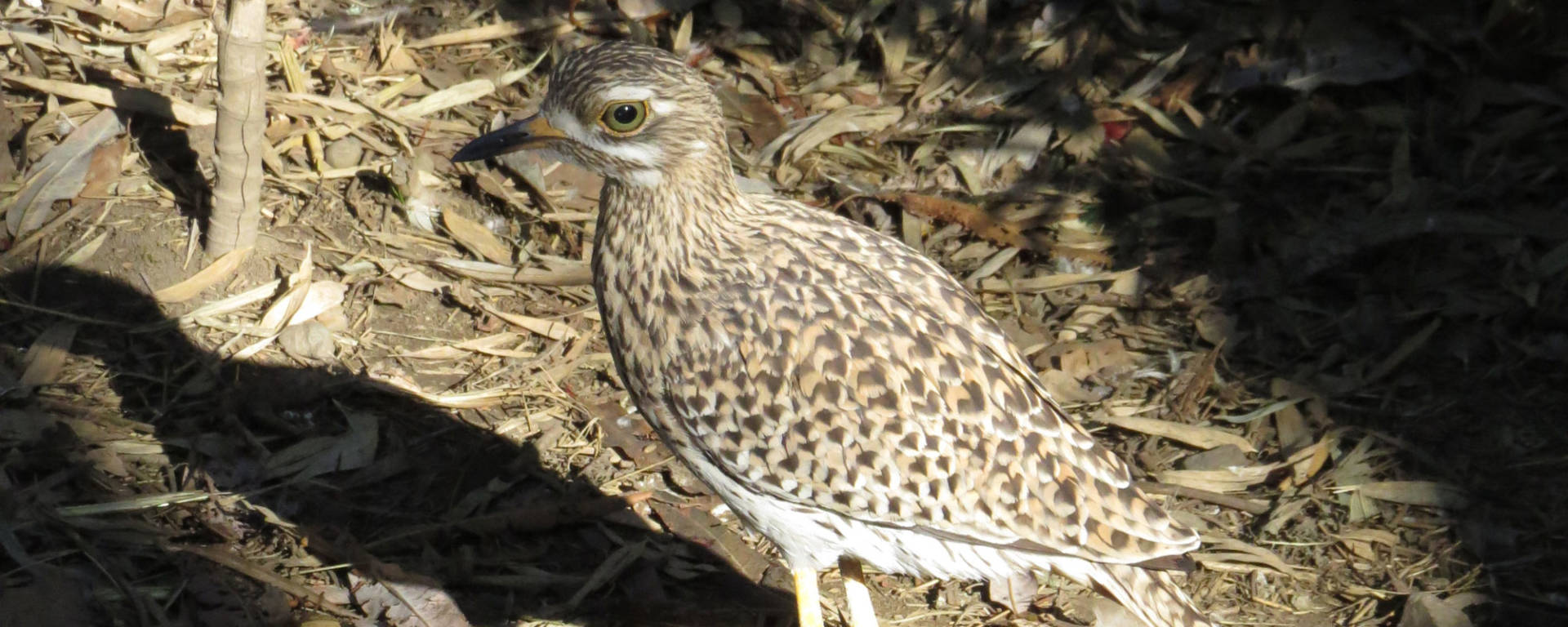Description
The Thick-knee’s (also known as the Spotted Dikkop) upper body is brownish beige with chest and belly whitish with some light grey streaks. The upper body is spotted black. Legs are yellow. Eyes are large with a yellow iris. Juveniles are more streaked than spotted. The beak is medium short and broad-based. Legs are yellow with a swollen “knee” joint, giving the bird its name. (Actually, this “knee” is the raised ankle joint, but it appears like a human knee). Thick-knees have a large, domed head; the Afrikaans word dikkop means thick head.
Classification
- Class
- Aves
- Order
- Charadriiformes
- Family
- Burhinidae
- Genus
- Burhinus
- Species
- B. capensis
- Conservation Status
- Least Concern
Key Facts
- Weight
- 375-600 g (1.3- 2 pounds)
- Height
- 37-44 cm (14 inches)
Social Life
Cape Thick-knees are solitary and sedentary, remaining in their home territory. They feed mainly at night, walking slowly forward or running and stopping to pick up food from the ground. They depend on their camouflage coloring to remain unnoticed. They are silent during the day but begin calling at dusk. The penetrating wailing calls sound eerie to humans. The reason for their vocalizations is poorly understood. As they are active after dark, they are difficult to study.
Habitat and Range
Dry sandy or rocky areas south of the Sahara in Africa, excluding the rainforest and wooded areas near the equator.
Diet
Insects, small amphibians, molluscs and some seeds.
Lifespan
About eight to twenty years.
Predators
Although not really a predator, sheep are dangerous to the eggs and chicks, as they may step on them. Ground-based predators such as snakes or introduced species such as domestic cats are also a problem for chicks and eggs.
Reproduction
They reach sexual maturity between two to three years. Cape Thick-knees are monogamous and solitary nesters; both parents care for the young. The nest is a shallow scrape, usually in the shade of a rock or bush and may be lined with leave or grass. Female lays 2 spotted (camouflaged) eggs and incubates them for 24 days. Chicks fledge at about 6 weeks.
- Information
-
Description
The Thick-knee’s (also known as the Spotted Dikkop) upper body is brownish beige with chest and belly whitish with some light grey streaks. The upper body is spotted black. Legs are yellow. Eyes are large with a yellow iris. Juveniles are more streaked than spotted. The beak is medium short and broad-based. Legs are yellow with a swollen “knee” joint, giving the bird its name. (Actually, this “knee” is the raised ankle joint, but it appears like a human knee). Thick-knees have a large, domed head; the Afrikaans word dikkop means thick head.
Classification
- Class
- Aves
- Order
- Charadriiformes
- Family
- Burhinidae
- Genus
- Burhinus
- Species
- B. capensis
- Conservation Status
- Least Concern
Key Facts
- Weight
- 375-600 g (1.3- 2 pounds)
- Height
- 37-44 cm (14 inches)
- Lifestyle
Social Life
Cape Thick-knees are solitary and sedentary, remaining in their home territory. They feed mainly at night, walking slowly forward or running and stopping to pick up food from the ground. They depend on their camouflage coloring to remain unnoticed. They are silent during the day but begin calling at dusk. The penetrating wailing calls sound eerie to humans. The reason for their vocalizations is poorly understood. As they are active after dark, they are difficult to study.Habitat and Range
Dry sandy or rocky areas south of the Sahara in Africa, excluding the rainforest and wooded areas near the equator.Diet
Insects, small amphibians, molluscs and some seeds.Lifespan
About eight to twenty years.
Predators
Although not really a predator, sheep are dangerous to the eggs and chicks, as they may step on them. Ground-based predators such as snakes or introduced species such as domestic cats are also a problem for chicks and eggs.
Reproduction
They reach sexual maturity between two to three years. Cape Thick-knees are monogamous and solitary nesters; both parents care for the young. The nest is a shallow scrape, usually in the shade of a rock or bush and may be lined with leave or grass. Female lays 2 spotted (camouflaged) eggs and incubates them for 24 days. Chicks fledge at about 6 weeks.

